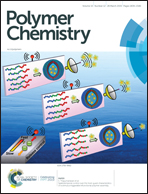The design of triple shape memory polymers with stable yet tunable temporary shapes by introducing photo-responsive units into a crystalline domain†
Abstract
A desirable triple-shape memory effect (triple-SME) showing stable yet easily tunable temporary shapes is achieved using a physically crosslinked network with photo-responsive coumarin-containing poly(ε-caprolactone) (PMCL) as soft segments and poly(L-lactide) (PLLA) as hard segments. A controlled ring-opening polymerization in combination with post-modification was utilized to introduce a small amount of coumarin units into the PMCL soft segments. As a result, both the soft and hard segments maintained high crystallinity. The copolymers exhibited a triple-SME with staged shape recoveries firstly upon heating, and then upon UV irradiation at λ = 254 nm plus heating, using a one-step deformation programming procedure under UV irradiation at λ = 365 nm when the dimerization of coumarin units was performed. By only adjusting the photo-crosslinking intensity and time, the ratios of the first and second shape recovery steps can be tuned and the ratio of the second recovery step was high up to 52.5%. Moreover, the temporary shape C was highly stable and can be used as a complex permanent shape for thermal sensitive SME.



 Please wait while we load your content...
Please wait while we load your content...